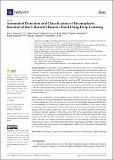Files in this item
Automated detection and classification of desmoplastic reaction at the colorectal tumour front using deep learning
Item metadata
| dc.contributor.author | Nearchou, Ines P. | |
| dc.contributor.author | Ueno, Hideki | |
| dc.contributor.author | Kajiwara, Yoshiki | |
| dc.contributor.author | Lillard, Kate | |
| dc.contributor.author | Mochizuki, Satsuki | |
| dc.contributor.author | Takeuchi, Kengo | |
| dc.contributor.author | Harrison, David J. | |
| dc.contributor.author | Caie, Peter D. | |
| dc.date.accessioned | 2021-04-01T09:30:15Z | |
| dc.date.available | 2021-04-01T09:30:15Z | |
| dc.date.issued | 2021-03-31 | |
| dc.identifier | 273498525 | |
| dc.identifier | 2a65d65a-e4b2-47d0-9d71-afaaa868b5b4 | |
| dc.identifier | 85103314932 | |
| dc.identifier | 000638359100001 | |
| dc.identifier.citation | Nearchou , I P , Ueno , H , Kajiwara , Y , Lillard , K , Mochizuki , S , Takeuchi , K , Harrison , D J & Caie , P D 2021 , ' Automated detection and classification of desmoplastic reaction at the colorectal tumour front using deep learning ' , Cancers , vol. 13 , no. 7 , 1615 . https://doi.org/10.3390/cancers13071615 | en |
| dc.identifier.issn | 2072-6694 | |
| dc.identifier.other | ORCID: /0000-0001-9041-9988/work/91685660 | |
| dc.identifier.other | ORCID: /0000-0002-0031-9850/work/91685819 | |
| dc.identifier.other | ORCID: /0000-0002-1863-5413/work/91685912 | |
| dc.identifier.uri | https://hdl.handle.net/10023/21753 | |
| dc.description | Funding: This study was funded by Medical Research Scotland, the Japan Society for the Promotion of Science, the British Council and Indica Labs, Inc. who also provided in kind resource. | en |
| dc.description.abstract | The categorisation of desmoplastic reaction (DR) present at the colorectal cancer (CRC) invasive front into mature, intermediate or immature type has been previously shown to have high prognostic significance. However, the lack of an objective and reproducible assessment methodology for the assessment of DR has been a major hurdle to its clinical translation. In this study, a deep learning algorithm was trained to automatically classify immature DR on haematoxylin and eosin digitised slides of stage II and III CRC cases (n = 41). When assessing the classifier’s performance on a test set of patient samples (n = 40), a Dice score of 0.87 for the segmentation of myxoid stroma was reported. The classifier was then applied to the full cohort of 528 stage II and III CRC cases, which was then divided into a training (n = 396) and a test set (n = 132). Automatically classed DR was shown to have superior prognostic significance over the manually classed DR in both the training and test cohorts. The findings demonstrated that deep learning algorithms could be applied to assist pathologists in the detection and classification of DR in CRC in an objective, standardised and reproducible manner. | |
| dc.format.extent | 3233248 | |
| dc.language.iso | eng | |
| dc.relation.ispartof | Cancers | en |
| dc.subject | Deep learning | en |
| dc.subject | Image analysis | en |
| dc.subject | Desmoplastic reaction | en |
| dc.subject | Colorectal cancer | en |
| dc.subject | Digital pathology | en |
| dc.subject | QA75 Electronic computers. Computer science | en |
| dc.subject | RC0254 Neoplasms. Tumors. Oncology (including Cancer) | en |
| dc.subject | E-DAS | en |
| dc.subject | SDG 3 - Good Health and Well-being | en |
| dc.subject.lcc | QA75 | en |
| dc.subject.lcc | RC0254 | en |
| dc.title | Automated detection and classification of desmoplastic reaction at the colorectal tumour front using deep learning | en |
| dc.type | Journal article | en |
| dc.contributor.institution | University of St Andrews. Cellular Medicine Division | en |
| dc.contributor.institution | University of St Andrews. Sir James Mackenzie Institute for Early Diagnosis | en |
| dc.contributor.institution | University of St Andrews. School of Medicine | en |
| dc.contributor.institution | University of St Andrews. Centre for Biophotonics | en |
| dc.identifier.doi | 10.3390/cancers13071615 | |
| dc.description.status | Peer reviewed | en |
This item appears in the following Collection(s)
Items in the St Andrews Research Repository are protected by copyright, with all rights reserved, unless otherwise indicated.

